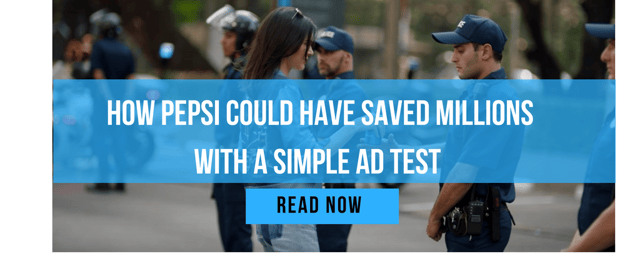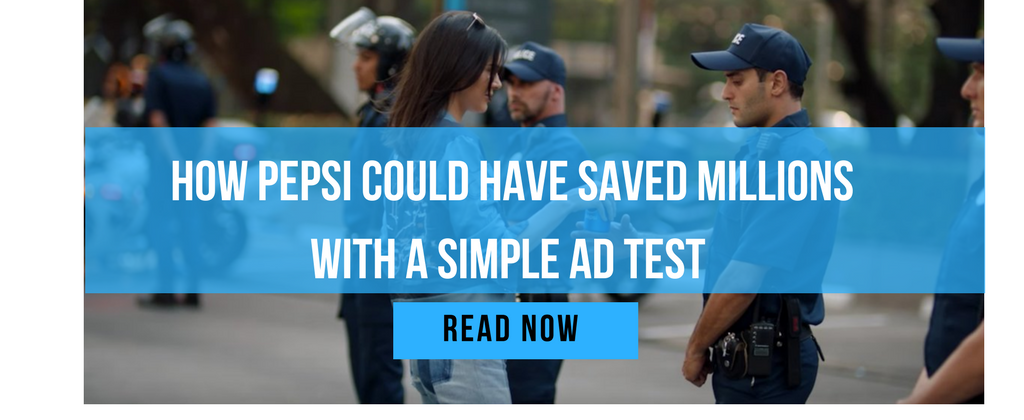
Every year, millions of dollars are wasted on failed advertisements. In fact, in the digital world, the success rate for a viral campaign is only about 15%.
The majority of failed ads are never paid much attention - hence the reason why they failed - but there are always a distinguished few that are bad enough to catch the public's attention, as well as an onslaught of bad press.
A recent example of one such major ad fail is Pepsi’s 2017 Live for Now ad featuring Kendall Jenner.
By now, most of you have probably seen the ad and the headlines that followed, but if you somehow haven’t heard about the ad yet, know this: Pepsi attempted to co-opt the Black Lives Matter movement to sell more soft drinks, and they did it with a rich white supermodel.
The ad seemingly did the impossible: it united the internet around a common belief. Unfortunately for Pepsi, the common belief was that Pepsi was tone deaf, inauthentic, and culturally insensitive.
Those are all awful things for a brand to be called.
But Pepsi will survive the negativity. They have the cash and the cache to do so.
The more important question is: do smaller brands and agencies have the cash and cache to survive a major faux pas in one of their advertising campaigns?
For many companies, the answer is “no”.
The Cost of Failed Ads
Small and medium size businesses spend anywhere between 3% and 8% of their annual revenues on marketing. That’s a substantial amount to put at risk. But it’s not just about the cost today. Businesses also have to factor in the lost goodwill that can result from a failed ad campaign and what that might cost the company in the future.
This is difficult to measure.
Financial experts say goodwill as a broader category can account for anywhere from a few percent to as much as 50% of a company’s overall value.
That’s a lot of money for any company to gamble with.
It almost never seems like a gamble, though - no one ever thinks what happened to Pepsi will happen to them. But don’t kid yourself. Pepsi has the resources to hire the smartest and most talented marketers. They have decades of experience creating successful ads.
Yet, here we are…
If it can happen to Pepsi, it can happen to you.
But it doesn’t have to happen to you - there are steps you can take to ensure you never end up on the wrong side of an ad controversy.

Why Ads Fail
Marketing experts have many opinions as to why ads fail. A closer inspection, however, reveals that the reasons ads fail really come down to the delivery of the RIGHT MESSAGE in the RIGHT WAY to the RIGHT AUDIENCE.
Successful ads most often hit on all of these pillars. However, ads that miss the mark on even just one, are much more likely to fail.
Pepsi’s Kendall Jenner Ad is a great example of an ad that hit on two pillars, but was way off on another - which unfortunately had disastrous consequences for the brand.
Let’s break down what Pepsi got right, and what they got wrong:

Right Message
According to Pepsi, the Kendall Jenner ad “was trying to project a global message of unity, peace and understanding.” Given the target audience of millennials, this was a solid message choice. Millennials tend to be progressive - just ask Bernie Sanders, and what are some of the core progressive messages: unity, peace, and understanding. Can’t knock Pepsi on this count. It’s a solid message.
Right Way
The right message means nothing if it’s not portrayed in the right way. Pepsi may have had the right idea in mind when developing the ad, but the message was lost in the execution. Instead of “a global message of unity,” the ad actually communicates the opposite - an insensitivity to the spate of recent protests against racial, gender, and political inequality. The incongruity of the target message and the message that was actually communicated is the biggest problem with the ad. It makes Pepsi appear inauthentic, ignorant, and offensive.
Right Audience
Pepsi is known for running ads that target a young and trendy audience. Remember the successful campaigns from the 90’s featuring pop stars like Britney Spears and Beyonce? Pepsi has historically been able to successfully appeal to this audience.
Given the brand Pepsi has built over the last couple decades, this was certainly the audience they should be targeting, however, as mentioned above, the right audience doesn’t matter if the message is executed in the wrong way. At best, it falls flat. At worst - like in the Kendall Jenner ad - it offends people.
The recent protest movements - including Black Lives Matter - are largely made up of millennials, and they are driven by issues that millennials are very passionate about. They don’t want to see corporate America exploit these movements for monetary gain, which is what many millennials felt the ad was doing. Therefore, while Pepsi was targeting the right audience, with the right message in mind, the execution was way off the mark, causing the enormous backlash.
If Pepsi had been able to communicate their message in the right way, the commercial probably would have been a hit.

How to Make Sure Your Ads Are Effective
I’d love to tell you creating effective ads is easy.
I’d love to say: “Just deliver the RIGHT MESSAGE in the RIGHT WAY to the RIGHT AUDIENCE and everything will work out great!”
You might even be expecting me to say that. But the truth is: it has historically been very difficult - if not impossible - to consistently produce effective advertisements.
It’s not that marketers are bad at their jobs - there are many great ads out there - but how much money did they spend on development and production? How many other ads failed before the right one was created? How much time and money was spent on research, or focus groups, or surveys before development even started?
The problem is that marketers are expected to know how their audience will respond to the ad, but they’re given mediocre tools - like surveys and focus groups - that don’t provide them with reliable information about how their audience will truly react.
That’s a tough gig for anyone.
Fortunately change is on the horizon. The advent of Artificial Intelligence has opened up a new world of possibilities. Companies like Dumbstruck - an innovative video-testing and analytics platform - have identified novel ways of combining cutting-edge technology with research in neuroscience, psychology, and advertising to develop ad testing technologies that can reliably predict how target demographics will respond to a campaign - before an ad is released.
Dumbstruck, for example, uses machine learning techniques to determine the emotions viewers experience for every moment of a video, giving advertisers the ability to accurately measure ad performance before launching a campaign. The platform also provides advertisers with actionable insights that show them exactly how to increase ad effectiveness.
With new video-testing technology like this becoming more readily available in the industry, advertisers will be able to create campaigns that are better optimized and more effective than ever before. They’ll also be able to do it easily, quickly, and affordably.
Of course now the question is: why wouldn’t you test your ads before running a campaign?
It’s something Pepsi should keep in mind.

Topics:
Ad Testing,
video marketing,
ad fails,
bad ads











